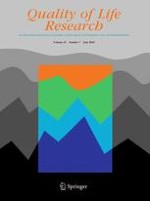01-07-2016
Measuring nonspecific factors in treatment: item banks that assess the healthcare experience and attitudes from the patient’s perspective
Gepubliceerd in: Quality of Life Research | Uitgave 7/2016
Log in om toegang te krijgenAbstract
Purpose
Nonspecific factors that accompany healthcare treatments, such as patients’ attitudes and expectations, are important parts of the experience of care and can influence outcomes. However, no precise, concise, and generalizable instruments to measure these factors exist. We report on the development and calibration of new item banks, titled the Healing Encounters and Attitudes Lists (HEAL), that assess nonspecific factors across a broad range of treatments and conditions.
Methods
The instrument development methodology of the Patient-Reported Outcomes Measurement Information System (PROMIS®) was used. Patient focus groups and clinician interviews informed our HEAL conceptual model. Literature searches of eight databases yielded over 500 instruments and resulted in an initial item pool of several thousand items. After qualitative item analysis, including cognitive interviewing, 296 items were included in field testing. The calibration sample included 1657 respondents, 1400 obtained through an Internet panel and 257 from conventional and integrative medicine clinics. Following exploratory and confirmatory factor analyses, the HEAL item banks were calibrated using item response theory.
Results
The final HEAL item banks were Patient–Provider Connection (57 items), Healthcare Environment (25 items), Treatment Expectancy (27 items), Positive Outlook (27 items), and Spirituality (26 items). Short forms were also developed from each item bank. A six-item short form, Attitudes toward Complementary and Alternative Medicine (CAM), was also created.
Conclusions
HEAL item banks provided substantial information across a broad range of each construct. HEAL item banks showed initial evidence of predictive and concurrent validity, suggesting that they are suitable for measuring nonspecific factors in treatment.
